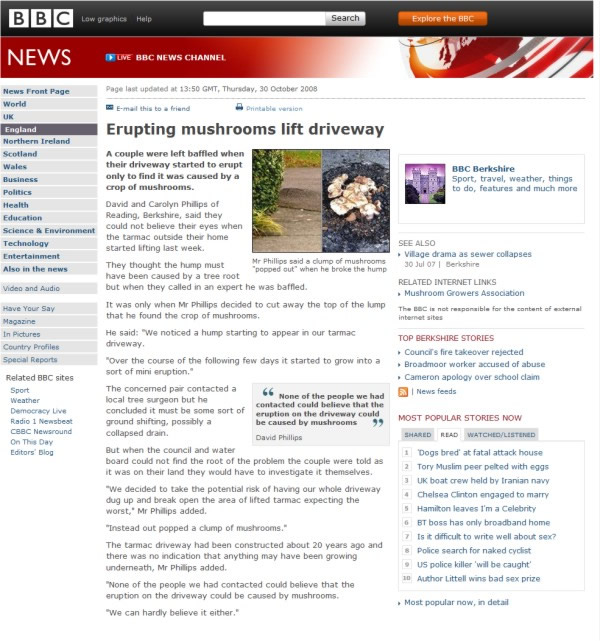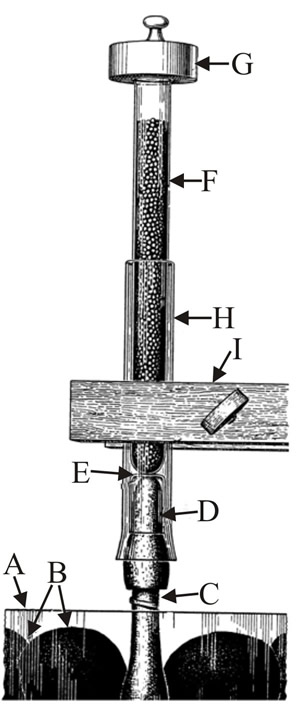13.3 Make the earth move
Saprotrophic fungi can be physically destructive even without digesting things. Mushrooms may be soft and squashy, but they have been known to lift stone slabs and force their way through tarmac. In the 1860s a famous mycologist called Mordecai Cubitt Cooke wrote A Plain and Easy Account of British Fungi (Cooke, 1862) in which he told of:
“...a large kitchen hearthstone which was forced up from its bed by an under-growing fungus and had to be relaid two or three times, until at last it reposed in peace, the old bed having been removed to a depth of six inches and a new foundation laid.”
Cooke also tells of a comparable observation made by a Dr Carpenter:
“...Some years ago the town of Basingstoke was paved; and not many months afterwards the pavement was observed to exhibit an unevenness which could not readily be accounted for. In a short time after, the mystery was explained, for some of the heaviest stones were completely lifted out of their beds by the growth of large toadstools beneath them. One of the stones measured twenty-two inches by twenty-one, and weighed eighty-three pounds..."
It’s not only 19th century structures that are prone to fungal attack. The BBC News website of 30th October 2008 carried a report about mushrooms lifting the tarmac driveway of a house in Reading, Berkshire (Fig. 1).
Another interesting pictorial example is on the back cover page of the April 1991 issue of the Mycologist, a magazine published by the British Mycological Society. This photograph shows fruit bodies of the puffball Scleroderma bovista coming through a tennis court. In this case the constructional history was recorded as follows:
"the original hard porous court made of fly ash was overlaid in 1989 with 75 mm of gravel and then a 20 mm layer of tarmacadam was rolled smooth over the top (Taylor & Baldwin, 1991). The first fruit bodies appeared in 1990 (Fig. 1B)."
 |
| Fig. 1. A couple were left baffled when their driveway started to erupt only to find it was caused by a crop of mushrooms… visit http://news.bbc.co.uk/1/hi/england/berkshire/7699964.stm to view the original story. |
Buller (1931) did some experiments in which he put weights on the top of developing mushrooms to see how much pressure they could exert (Fig. 2). He worked out that a single mushroom could apply a pressure of at least two thirds of an atmosphere - that is about ten pounds per square inch. It’s all a matter of hydraulics, of course; as we indicated in Chapter 6 (in our ‘hydrostatic bricks’ discussion; CLICK HERE to view the page), the mushrooms can fill themselves with water and force their way through cracks and crevices. They are not doing it because of some perverse intention to break up paving, but because in nature they need to push through soil and plant litter in order to bring their fruit bodies to a position from which they can release their spores to the breeze; if there happens to be a tennis court in the way, then game, set and match to the fungus!
 |
Fig. 2. Diagram of an experimental rig (original appears as Fig. 67 in Buller, 1931) to test the ability of fruit bodies of Coprinus sterquilinus to lift quantities of lead shot. The Coprinus fruit body (C) had grown on some balls of horse dung (B) incubated in a glass dish (A) in the laboratory. A glass tube (H) was placed over the fruit body to stabilise it with clamp (I) and then the fruit body cap (D) was covered with a small glass beaker (E) and then loaded with a test tube containing lead shot (F) to a total weight of 150 g. The fruit body grew a further millimetre in 2 h after this and even the addition of a further 50 g weight (G) did not decrease the rate of growth. Only when the overall loading was increased to 300 g did the fruit body stem (C) bend and break. |
Updated July, 2019
